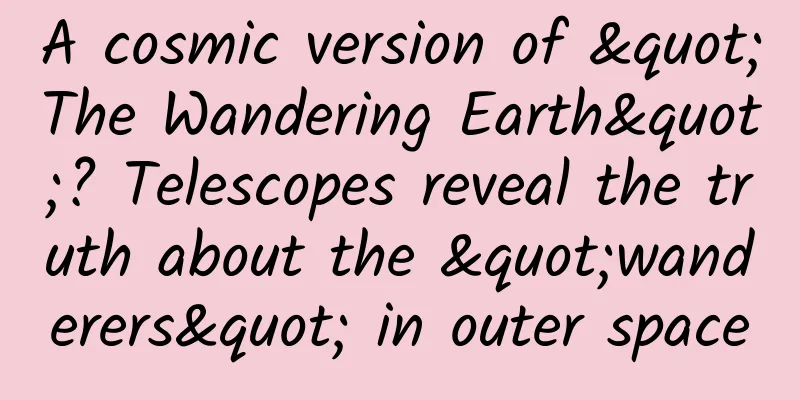A cosmic version of "The Wandering Earth"? Telescopes reveal the truth about the "wanderers" in outer space

|
Produced by: Science Popularization China Author: Feng Guojie, Marija Duisken (Xinjiang Astronomical Observatory, Chinese Academy of Sciences) Producer: China Science Expo Editor's note: In order to unveil the mystery of scientific work, the China Science Popularization Frontier Science Project launched a series of articles called "Me and My Research", inviting scientists to write articles themselves, share their scientific research experiences, and create a scientific world. Let us follow the explorers at the forefront of science and technology and embark on a journey full of passion, challenges, and surprises. In addition to the sun and the eight well-known planets, there are many other substances in the solar system, such as satellites, stellar dust and other small celestial bodies. Among them, the trajectory changes of meteors, comets and near-Earth asteroids have attracted much attention from the public and have become "stars" on the earth. The Nanshan 1-meter Wide Field Telescope (NOWT) of the Xinjiang Astronomical Observatory of the Chinese Academy of Sciences can capture the traces of these "stars". On March 8, 2024, NOWT captured a moving celestial body. The next day, the Xingming Observatory, formed by astronomy enthusiasts, used a half-meter telescope (HMT) to follow up on this "wanderer" from outer space and reported the observation data to the International Minor Planet Center (MPC). One-meter wide-field optical telescope (NOWT) at the Nanshan Observatory of Xinjiang Astronomical Observatory (Photo source: Tianshan Net, provided by Xinjiang Astronomical Observatory of the Chinese Academy of Sciences) The misunderstood comet Asteroids and comets are always confused in the initial observation because they can move within the solar system and appear as bright spots in the night sky when they are close to the Earth. Therefore, both astronomers and experienced observers need to observe and record continuously to distinguish asteroids and comets more accurately. On April 10, 2024, German astronomer Robson Hahn reported the target as a Near-Earth Object Candidate (NEOCP) and it was assigned the provisional number 2024 FG9 by MPC, and the electronic notice MPEC 2024-G199 was issued. On April 17, 2024, S. Deen, an American amateur astronomer who is keen on finding lost and unknown celestial bodies in the solar system, found that 2024 FG9 showed the activity characteristics of a comet in the observation data before the target was discovered. He used a 0.43-meter telescope in Chile to observe it and found that the celestial body had a comet tail of 4 arc seconds (arc seconds is an angle unit, 1 arc second = 1/3600 degree, 4 arc seconds = 0.001111111111 degrees). Later, more observers observed the comet characteristics it showed, and these data further proved that it was a comet. On June 1, 2024, the International Minor Planet Center issued an electronic notice (MPEC 2024-L04, link: MPEC 2024-L04: COMET P/2024 FG9 (Nanshan-Hahn) (minorplanetcenter.net)), officially announcing that asteroid 2024 FG9 is a comet and renamed it P/2024 FG9 (Nanshan-Hahn), which is translated into Chinese as Nanshan-Hahn Comet. That night, the Central Bureau of Astronomical Telegrams (CBAT) issued the electronic notice No. 5401, which detailed the discovery process of the comet. The NAS team (NOWT Asteroid Survey), a small planet search project jointly conducted by the Xinjiang Astronomical Observatory of the Chinese Academy of Sciences and the Xingming Observatory, first discovered and reported the target and shared the discovery with Robson Hahn. The aphelion of Comet Nanshan-Hahn is close to the orbit of Jupiter, and the perihelion is near the orbit of Mars. Therefore, its orbit is very susceptible to changes due to the gravitational influence of Jupiter and Mars. The comet reached perihelion on May 20, with a maximum brightness of 17.5 magnitude (magnitude is a measure of the brightness of a celestial body, in layman's terms, the brightness level of a celestial body. The larger the magnitude, the darker the celestial body. For example, the magnitude of the sun is -26.7, and the magnitude of the North Star is 1.98), an orbital period of about 5.88 years, and an orbital inclination of about 1.73 degrees. It is a short-period Jupiter family comet. Simulated orbit of Comet Nanshan-Hahn (Photo source: Xinjiang Astronomical Observatory) Difference Between Comet and Asteroid An asteroid is a small, rocky object that looks like a point of light when viewed through a telescope. Most asteroids are found in a ring between the orbits of Mars and Jupiter called the asteroid belt. Comets are different from asteroids in that they are usually composed of ice, rock and dust, and are called "dirty snowballs". When they are close to the sun, their ice and dust will evaporate. When observing comets through a telescope, they will appear blurry and have a long tail. The shortest tail can be 10 million kilometers, and the longest can reach 320 million kilometers, which is more than twice the distance from the sun to the earth! When a comet approaches perihelion (usually about 300 million kilometers from the sun), it will form a tail. The combined effects of solar radiation pressure and solar wind will blow away the gas and dust in the comet nucleus, forming two separate tails (coma and tail). If the comet is large enough and close enough to the earth, people can see the comet through the sunlight reflected by these gases and dust. (Photo source: veer photo gallery) The fate of a comet Will this "wanderer" that breaks into the solar system eventually stay or leave? Most comets originate in the Kuiper Belt or the Oort Cloud beyond, where they spend most of their lives, at temperatures close to absolute zero. Once a comet enters orbit in the inner solar system, its previously uneventful life begins to speed up. Some comets survive a pass near the Sun and return to the cold of space; some may collide directly with the Sun or pass so close that they are destroyed near perihelion; and still others may not pass that close at all, but instead interact with one or more planets. By measuring the amount of gas and dust in the atmospheres of comets that don't end their lives, it's possible to estimate their total loss during one orbital cycle. The typical loss rate for an active comet close to the Sun is about a million tons per day, or tens of millions of tons per orbit. At that rate, a typical comet would be gone after just a few thousand orbits, and that may have been the fate of Halley's Comet. Comets may also escape the solar system. In 2019, astronomers discovered Comet 2I/Borisov, which came from a planetary system outside the solar system. It was the second interstellar object discovered by humans and the first to be rich in substances such as carbohydrates. The comet contains much more carbon monoxide than ordinary solar system comets, indicating that it may have formed in a cooler place, perhaps around a red dwarf star. Conclusion People have had observation records of comets very early. There is a written record about Halley's Comet in the ancient "Spring and Autumn Annals" (613 BC): In the seventh month of autumn, a star entered the Big Dipper. People's journey to discover comets has continued to this day. Now people can rely on more professional observation equipment to discover their elusive orbital "traces". I believe that with the in-depth cooperation between the Xinjiang Astronomical Observatory and the Xingming team, more interesting cosmic "stars" will be discovered in the future. |
Recommend
Creating JavaScript modules with Babel and ES7
Last year, a new version of JavaScript was releas...
Is 95# oil more resistant to burning than 92# oil? The list of "scientific" rumors in March 2025 is released
This is Beijing Association for Science and Techn...
22 mobile game companies were named. Will the high growth of mobile games come to an end?
Yesterday, the Ministry of Culture released the 2...
Xiaomi 3 configuration top-level appearance mediocre leather case slightly lower-end 16GB version 1999 yuan
[September 9 news] If the hardware configuration ...
Who controls the fate of Didi Chuxing?
A turbulent undercurrent set off by "Didi Pr...
【Creative Cultivation Program】Rutherford: What's inside the nucleus? Open it and see
Author: Tian Dawei Thanks to the joint efforts of...
The world is too complicated! How to explore simple rules?
1. Complex world, simple rules In the sunset, bir...
A guide to building a Douyin Blue V account matrix!
Douyin's Blue V ecosystem is very complex, an...
Gehua Cable TV will be the next Wasu Media
Gehua Cable sells a large order of 33 yuan On Marc...
Tips for increasing followers through short video operations!
1. Current status of short video development Shor...
Many vehicles collided on the Zhengxin Yellow River Bridge in heavy fog. What should you pay attention to when driving in fog?
Science Fiction Network, December 28 (Jin Kaiyi) ...
Programmers need to have continuous output
I believe that all programmers need to find a goo...
Tik Tok live broadcast promotion operation tips!
How to increase the popularity of Douyin live str...
Only 4 steps are needed to increase the appeal of Tik Tok video ads!
In Tik Tok, you often see those popular video adv...
The principles and applications of iOS compilation process
Preface Programming languages can generally be ...









